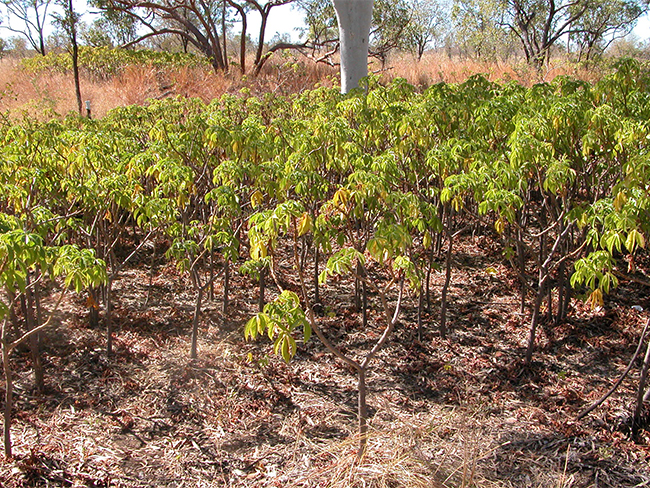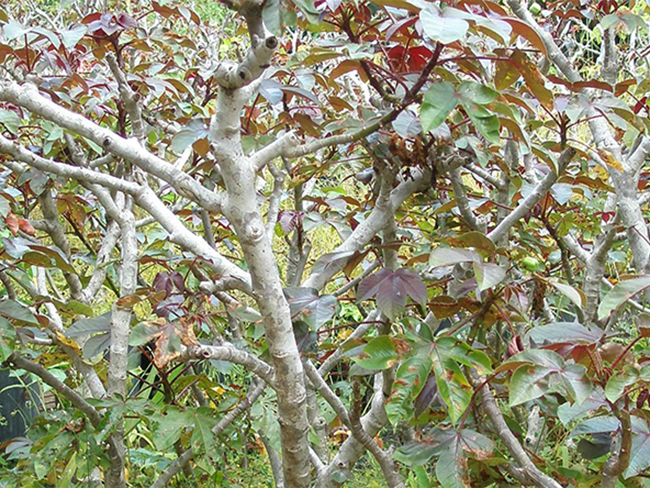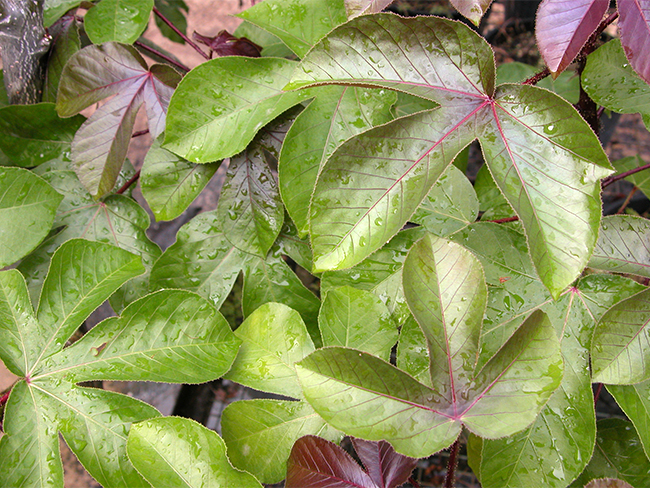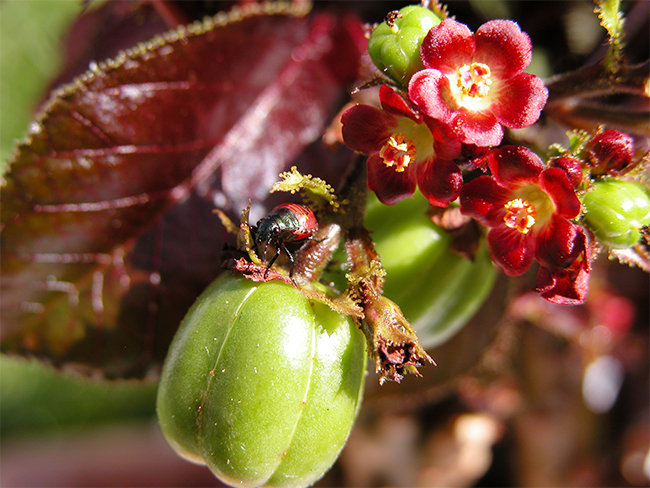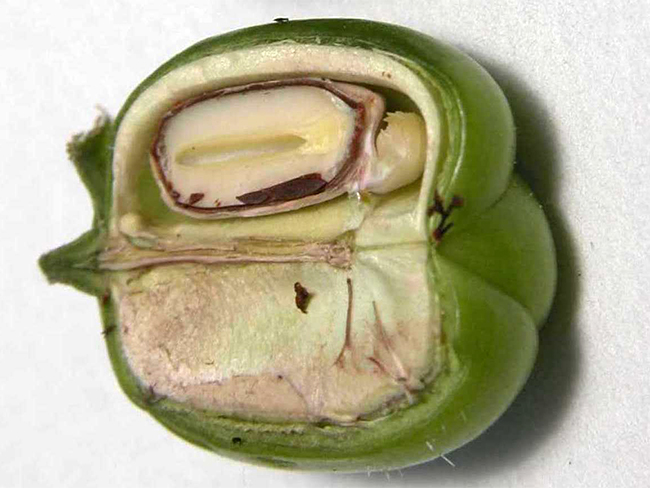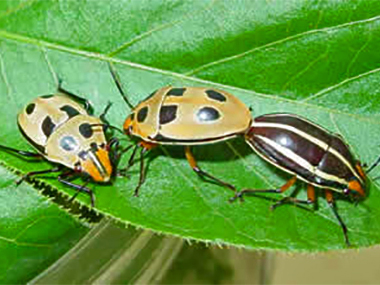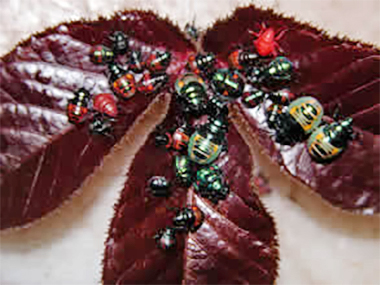Bellyache bush
Scientific name: Jatropha gossypiifolia
Declaration status: Class A weed except in areas where it is classified as Class B
Bellyache bush has a statutory weed management plan which outlines the legal requirements for control.
Go to Territory Stories website and read:
- weed management plan for bellyache bush 2023 - 2033
- discussion paper: weed management plans for mimosa and bellyache bush 2023 - 2033.
For more information, you can also read the weed management guide PDF (1.5 MB).
Bellyache is a Weed of National Significance. For more information, go to the Weeds Australia website.
Bellyache bush is a native of Central and South America.
It has been introduced as an ornamental and medicinal plant to many tropical countries where it has since become naturalised. Multiple deliberate introductions of bellyache bush into Australia resulted in naturalisation by the 1920s.
Bellyache bush is widespread across northern Australia, especially along watercourses.
It has been recorded in at least 30 localities across the Northern Territory (NT).
These sites range from extensive well established infestations in the Daly river catchment, through to isolated sites in the Darwin, Katherine and Gulf regions.
Bellyache bush rapidly forms dense monocultures in areas where native vegetation is degraded. It thrives in riparian zones and can also spread into intact savanna woodland and grassland habitats.
Impact
Bellyache bush can have all of the following impacts:
- forms dense thickets
- hinders mustering
- obscures fence lines
- restricts growth of native plants
- highly toxic to stock and people.
Identification
You should use this as a guide. There may be other plants or weeds that look similar.
- erect, perennial shrub up to 4m tall averaging between 2m and 3m
- multiple thick stems with branching from a similar central trunk
- stems covered with coarse, gland tipped, sticky, brown hairs
- stalks and margins covered with coarse, gland tipped, sticky, brown hairs
- alternate and divided into three to five segments
- pointed leaf lobes
- ‘Darwin Purple’ has predominantly purple/red foliage, ‘Katherine Green’ has green foliage
- flowers are small and red with yellow centres grouped in clusters around the top part of the plant
- fruit capsules are oblong
- approximately 1cm in diameter containing three to four seeds
- each seed is about 0.8cm long.
To find out more, get the bellyache bush weed note on the Department of Lands, Planning and Environment website.
If you're unsure, contact the Weed Management Branch (WMB).
Similar looking plants
The below plant species look similar to bellyache bush.
Castor oil plant
Castor oil plant (Ricinus communis) has leaves with 7 to 9 lobes and flowers in spikes.
Find out more about castor oil plant.
Physic Nut
Physic Nut (Jatropha curcas) also naturalised in northern Australia, has leaf margins and leaf stalks without gland-tipped hairs and petals that are yellow to green.
Find out more about physic nut.
Control
To find out about controlling and managing bellyache bush, watch the videos below.
Foliar spraying to control bellyache bush
Controlling isolated infestation of bellyache bush
Broad scale management of bellyache bush
Types of control
Below are the treatment methods you can use:
- chemical control
- non-chemical control.
Chemical control
The best time to treat bellyache bush is from December to April. Below is a list of treatment methods that can be used.
| Chemical and concentration | Rate | Situation, method and notes |
|---|---|---|
|
Fluroxypyr 200 g/L Various trade names |
500mL / 100L 3L / 100L (diesel) |
Seedling (individuals or infestation): Foliar spray – apply when actively growing Adult (individuals): Cut stump or basal bark For boom rate contact the Weed Management Branch |
|
Fluroxypyr 333 g/L Various trade names |
300mL / 100L 1L / 100L (diesel) |
Seedling (individuals or infestation): Foliar spray – apply when actively growing Adult (individuals): Cut stump or basal bark For boom rate contact the Weed Management Branch |
|
Metsulfuron-methyl 600 g/kg Various trade names |
10g / 100L 10g / 100L |
Seedling (individuals or infestation): Foliar spray - apply when actively growing, wetting agent required Adult (infestation): Foliar spray For broadscale application contact the Weed Management Branch |
|
Picloram 44.7 g/L and Aminopyralid 4.47 g/L Vigilant™ II | Gel |
Small plants or saplings: Cut stems horizontally – apply 3-5mm thick layer over the cut surface |
Non-chemical control
There are 5 ways of controlling gamba without the use of chemical.
Hand pulling and grubbing
Weeds, including their roots, are physically pulled out of the ground by hand or using hand tools.
This is an effective method of control for individual weeds and recent outbreaks that haven't released seeds yet, but it requires a lot of labour.
Slashing
A brush-cutter, slasher or mower are used to cut weeds off above the ground level.
This will not eradicate bellyache bush however it will kill most plants, reduce the biomass, provide easy access for other treatment options and create opportunities for more desirable species to establish.
Ensure equipment and machinery is cleaned prior to moving to new sites.
Fire
Bellyache bush is sensitive to fire, providing there is enough grass or other vegetation to carry a fire.
Young plants tend to be more susceptible than mature plants.
A large portion of the seed bank will usually survive, as many are buried beyond the reach of lethal temperatures.
Stock removal
Removing stock from areas which have been treated for weeds is a common management technique used by land managers.
This can be done in short periods (pasture spelling), or it can be a reduction in stock numbers rather than complete removal.
Supplementary feeding will also reduce grazing pressure on the land and allow the re-establishment of desirable plants which will compete with the undesirable weeds.
Biocontrol
2003 – Seed sucking bug (Agonosoma trilineatum)
Adult Agonosoma
Agonosoma nymphs on bellyache bush leaf.
One insect has been released as a biocontrol agent against bellyache bush. The seed sucking bug feeds by inserting its mouthparts into the fruit and injecting a liquid that dissolves the seeds, thus destroying the seeds before they mature. Thousands of Agonosoma have been released in the NT, but have failed to establish. Bellyache bush remains a prime target for biocontrol.
Spread
Bellyache bush spreads from stem and root segments including dumped cuttings, slashed plants and plants damaged in events such as flooding.
The pods explode when ripe, spreading seed up to 13m from the parent plant.
Bellyache bush seed can be spread via:
- water
- ants
- livestock and other animals
- machinery contaminated with seed.
Spread prevention
You can prevent the spread of bellyache bush by doing all of the following:
- map infestations to help develop a management plan
- design and implement a seed spread prevention program
- control minor infestations, isolated outbreaks or seedlings first
- designate wash down areas and actively work to prevent contamination of clean areas
- schedule works prior to seeding
- spray/destroy any plants that establish on fence lines, fire breaks and roadsides or outside paddocks
- ensure any gravel, sand, livestock, hay or any other product is free of seeds
- where possible integrate weed management into a broader natural resource management program - weeds often thrive in degraded areas, such as those impacted by erosion, wild fire and feral animals
- monitor areas that you have treated and watch for re-infestations.
Give feedback about this page.
Share this page:
URL copied!
